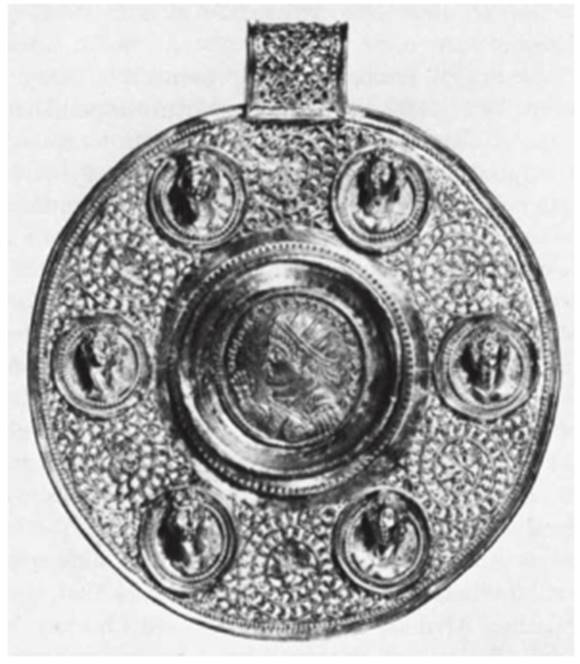Pendant. Sirmium (?), 324-326. Gold
The medallion has in its center a gold double solidus of Constantine I with the legend dn const antinus max aug on its obverse. On the reverse are facing busts of the Caesars Crispus and Constantine II in consular dress, the legend crispus et const antinus nob caes coss ii, and siRM(ium) in the exergue. The medallion is set within a plain frame with an outer row of beading, which is repeated on the outer edge. Within these are scrolls in openwork with leaves and six imperial busts in high relief within borders like the central medallion. The loop at the top is in the same openwork as the background of the pendant.

The pendant is part of a group of jewelry sold at Christie's (London, 1970) that included another circular pendant and two hexagonal pendants— also double gold solidi celebrating the second consulate of Crispus and Constantine II—a bracelet, and four fragments from a necklace, all with the same pierced work.
Such pendants had been popular in the late Roman Empire and continued far into the Byzantine period. They were usually circular but at times were hexagonal; often they were embellished with openwork (for an important discussion of these, see Vermeule, 1975, p. 27).
The double solidus here was struck at Sirmium in 324. The necklace to which our pendant belonged, celebrating Constantine the Great, Crispus, and Constantine II, would have had to be made before the summer of 326, when Crispus fell from grace and was murdered.
The design with imperial images about the central motif, as here, was known in Roman times, as on the famous gold patera from Rennes now in the Cabinet des Medailles in Paris (Vermeule, 1975, fig. 1).
This necklace, a gift doubtless celebrating the vicennalia, either in Nicomedia on 25 July 325 or in Rome on 25 July 326, would have been made in one of the imperial mints in Nicomedia, in Thes- salonike, in Sirmium, or in Rome, the cities known to have mints of Constantine the Great at this time. Since he stopped at Sirmium on his way from Nicomedia to Rome in 326, it is possible that the necklace was made there.
It is not known, however, for whom the necklace was made. The two most important ladies at court were the empress Fausta and the dowager empress Helena. For various reasons the latter is more likely. Bibliography: London, Christie's, 19 October 1970, no. 200; Bastien, 1972, pp. 49-82, esp. n. 4; Duval, 1973; Vermeule, 1975, pp. 5-32, esp. p. 27.
Date added: 2025-08-31; views: 77;
